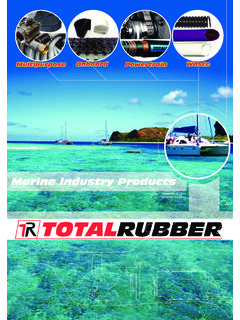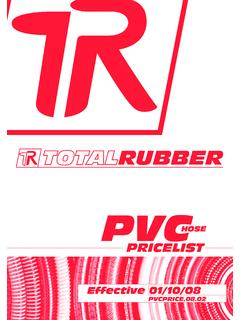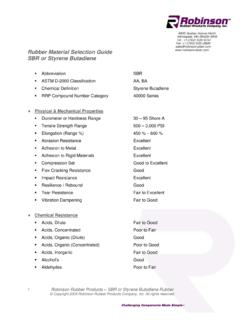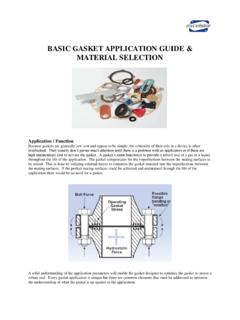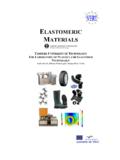Transcription of - Technical - Rubber Hose, PVC Hose, Rubber Matting
1 - Technical - CONTENTS- Custom Built Hose- Pressure Chart- Workshop- Hose Usage guide - Rubber Properties- Hose selection guide - Chemical Resistance ChartTo wnsville QLDNth Brisbane QLDB risbane QLDHead Office,Melbourne VICS unshine VICL aunceston TASP erth WAAuburn NSWW odonga VICN ewcastle NSWA delaide SAFlow Ratel/mHose Internal Pressure (kPa)Hose Internal Diameter (mm) of Free Air1520304050607080901001251505038568015 3026904230-------64160270565102016302350 317041855270---76--215330520745102013351 675203531904590 Size(mm) of Free Drop In HosesThe following tables of pressure drops and flow rates are based on experimental data and may be considered typical of most hoses. The data is based upon hoses laid out in a straight line and thus it must not be considered as an exact result that may be obtained at a given pressure. Variables such as hose fittings and bends increase the frictional losses and an estimate of their effect may be detirmined by adding an equivalent length to the hose of the equivalent length (Le) may be detirmined using the inside diameter (D) of the hose in the following swept elbow - Le = 20D90 square elbow - Le = 50D45 square elbow - Le = 16 DHose coupling - Le = 5 DPressure Drop of Air Through Rubber HoseVolumetric Flowrate of Water Through 100m Hose (litre/min.)
2 Pressure Drop (kPa/100m) Water at 20 C Through Hose- Technical InformationInformation About RubberCommon NameASTM DesignationCompositionGeneral PropertiesButylIIRI sobutylene IsopreneExcellent weathering resistance, low permeability to air and gasses, good physical properties, heat resistant, poor resistance to petroleum based Linked PolyethyleneXLPEC ross Linked PolyethyleneExcellent resistance to a wide range of solvents, chemicals, acids and oils (including aromatice).EPDMEPDME thylene Propylene ozone, chemical and ageing characteristics. Poor resistance to petroleum based fluids, very good steam Propylene CopolymerExcellent ozone, weathering, heat, chemical and ageing resistance, low permeability to water, not oil PolyethyleneExcellent weathering, ozone and acid resistance. Good heat and abrasion resistance and a fair resistance to petroleum based RubberNRIsoprene NaturalExcellent physical properties, very good abrasion resistance. Acid resistant but not oil (Perbunan-C)Excellent weathering resistance, flame retardent, good oil resistance and good physical (Buna-N)NBRN itrile ButadieneExcellent oil resistance, moderate resistance to aromatics and good physical MonomerExcellent oil and tar resistance at high ButadieneGood physical properties, good abrasion resistance, poor resistance to petroleum based high temperature resistance, particulary in air and oil, very good chemical PropertiesCustom Built HoseBeaded ends or swivel flanges are the most common hose termination.
3 The ability for the flange to swivel before tighten allows for easy bolt hole allignment a n d a l s o a l l o w s h o s e rotation to maximise hose wear without the need to remove the flange spigots can be built into the assembly in most flange styles and materials. T h e s e a r e s u i t e d f o r applications that do not require regular hose u f f e d o r s o f t e n d s a r e normally applied to hoses that require a fitting to be inserted and externally clamped. Cuffs can be enlarged to accomodate different diameters at each end of the end termination can be built for applications that require special end fittings to be attached after manufacture such a s i n t e r n a l s w a g e fittings or muff (swivel) FlangeFixed FlangeCuffed (soft ends)Plain EndCustom Rubber hose Totalrubber custom built hose assemblies are designed for each customers unique application. The design department has over 25 years experience in this specialty mandrel built hose field and have sales representation throughout and the highest quality materials are used in the construction of these hose assemblies.
4 Rub-ber compounds are selected to produce the best performance for each application. Hoses can be constructed with soft wall for pressure delivery or hard wall incorperating a helix wire for suction. Sizes range from 25mm to 2000mm in diameter and continuous lengths up to 1,200 metres! Total- Rubber specialise in corrugated exterior hoses to give maximum are endless possibilities for custom built hose applications, some of the most common are:- Mining abrasive slurry transfer- Dredging operations- Pumping and irrigation- Stacker reclaimer reeling hose- Mineral processing- Road sweeper hose- Offshore exploration transfer hose- Dock hose to BS1435- Grain transfer- Concrete pumping and pump squeeze tubes- Food and beverage transfer- Acid and chemical hose standard and custom assemblies f o r a l a r g e r a n g e o f a p p l i c a t i o n s from single units to bulk Workshop FacilityPlain end stems are the base fitting that can be threaded, welded or grooved to create many different styles of end is not recommended that fittings be welded afted swaging as this may damage the hose and cause premature (Butt-weld)
5 Male threaded fittings can be supplied in BSP, NPT and swaging threaded f i t t i n g s c a n t h e n b e connected to female threaded adaptors and couplers such as camlocks, flanges, bends etc, the options are ThreadFixed flange fittings are an economical flange end for use in applications that do not require critical flange hole allignment or periodical hose rotation to maximise hose available in a n y n o n r e d u c i n g flange table FlangeSwivel flange fittings are most benificial in applications where flange allignment is u n k n o w n a n d i n situations that require periodical hose rotation to maximise hose available in any non reducing flange table FlangeMilk thread fittings are available in both female and male configurations. Milk thread fittings are manufactured from solid bar which elimenates weld seams that could potentially trap bacteria, making them ideal for use in the wine and food processing ThreadHOSE selection guide - Reprinted from RAM hose best performance, a hose should be selected to meet the service conditions under which it is to beused; before deciding on the size, type and quality of the hose, complete information on the actual service requirements should be examined.
6 The information selection guide below will be of assistance in compiling the information Hose dimensions (a) Inside diameter. (b) Outside diameter. (c) length (state whether overall length or length excluding couplings). (d) tolerance limitations (if normal RMA tolerances can t be used).2. Type of Service (a) material to be conveyed through hose:- 1. chemical name. 2. concentration. 3. temperature extremes (low and high). (b) working pressure (including surge). (c) suction or vacuum requirements (water column or inches of mercury).3. Uncoupled hose ends (a) straight or enlarged. (b) capped or raw (uncapped). (c) soft ends or wire to Coupled hose fittings (a) type of fittings:- 1. male or female. 2. type of thread. 3. non-re-attachable. 4. TOTALRUBBER range of Rubber hose consists of two styles of construction: 1. Wrapped (hand built) constructionTube, plies, reinforcing and cover are spirally wrapped by hand onto a rotating steel tube (mandrel), cured with steam, then type of construction produces a hose with a fabric like overlapping Extruded (braided) constructionTube, braid and cover are extruded and braided through a production line of machines in a continual single process.
7 The product is cured using steam or hot sand, then coiled. This type of construction produces a hose with a smooth consistant wire, textile reinforced it consists of a Rubber tube, plies of synthetic wire, steel reinforcedit consists of a Rubber tube, plies of steel reinforced hose, smooth cover it has at least o n e w i r e a d d e d t o t h e reinforcement component of the reinforced hose, Single and double helix designed for better weight, flexibility and crush wire, braided hose consists of an extruded tube and cover with layers of braided synthetic USAGE guide - Hose usage guideHose LifeWe are often asked how long a length of hose may be expected to last and it is a question to which it is impossible to give a quantitative answer. We can however, consider the factors which may cause a hose to fail and it is convenient to break these down into chemical and mechanical failures, although the two factors frequently hoses frequently find themselves in mechanically damaging environments and deteriorating forces including but not limited to abrasion, impacts, tension, torsion, kinking, crushing and gouging.
8 The ability of a hose to resist such damage depends partly on the design of the hose and partly on the severity and frequency of the forces subjected on the hose. Common sense dictates that elimination or minimisation of abrasive conditions will prolong a hoses life. Where it is impossible to avoid such conditions, the choice of a quality hose designed for the application will pay dividends. Quality costs money but in the long run, quality is money well , hoses are required to transport oils, acids or chemicals and it is important that the compounds used in the construction of the hose are suitable for the materials to be carried. The chart on the following pages provides a guide , but ultimately it is necessary to evaluate the hose in the field. Oils and solvents cause swelling of rubbers and may also extract constituents from the Rubber the most important factor to remember when specifying a hose is: whatever the form of attack, it will be more rapid at higher temperatures; the rate of attack roughly doubles for every 10 C rise in temperature.
9 Hose life can be prolonged by draining the hose of its contents when not in use. Rubber Hose should be used as a transfer device and not a storage device. Oxygen and ozone in the atmosphere also attack Rubber , commonly known as weathering. Attack by ozone is particularly vicious even when present to the extent of only a few parts per million. Common exposure of hose to ozone comes from being in the vicinity of electric welding operations or of sparking electric motors and measures should be taken to minimise exposure to such conditions. Other oxidative elements sometimes present in the atmosphere (eg. Oxides of nitrogen or sulphur) can also be very damaging. Ozone is particularly damaging where a hose is under slight stress, eg. Over a coupling, at a kink or on the outside of a bend. The characteristics of ozone attack are the development of cracks across the line of stress. Where a hose is failing rapidly in service, it is important to identify whether this is for mechanical or chemical reasons.
10 A slight change in the operating conditions may be all that is required to remove the damaging Bend RadiusTight radius bends impose stresses on the structure of the hose which may be sufficient to cause reduction in the performance (temperature/vacuum) of a hose. In extreme cases, over bending a hose can cause permanent deformation and damage to the hoses minimum bend radius depends on many factors of the construction including the thickness of the wall, the presence and strength of an embedded wire helix, the reinforcement method employed and the degree of reduction in performance which can be consistency, a minimum bend radius should be measured to the inside surface of the bent hose and care should be taken to consider the tightest part of the Rubber is to some degree permeable. A hose conveying a gas will always have a slight permeation through the hose wall. Blistering of the hose will occur due to trapped gas beneath the cover if the rate of the permeation through the lining is faster than the hose.


